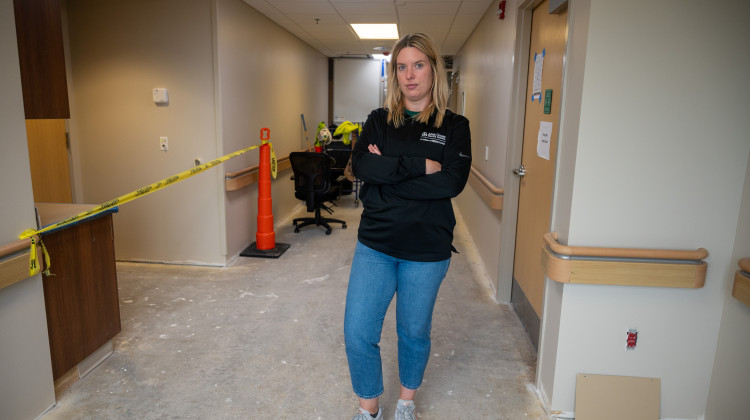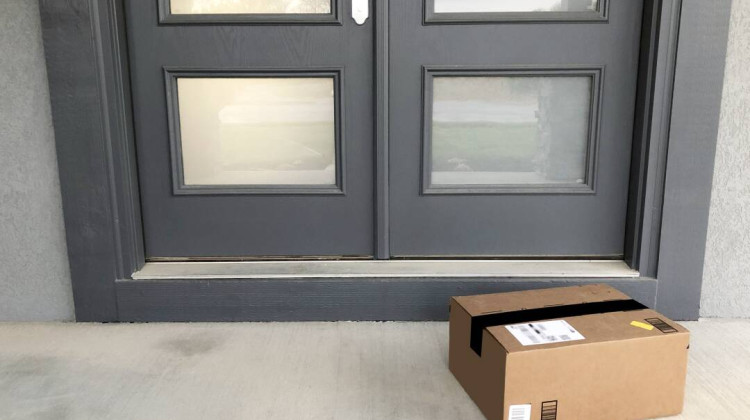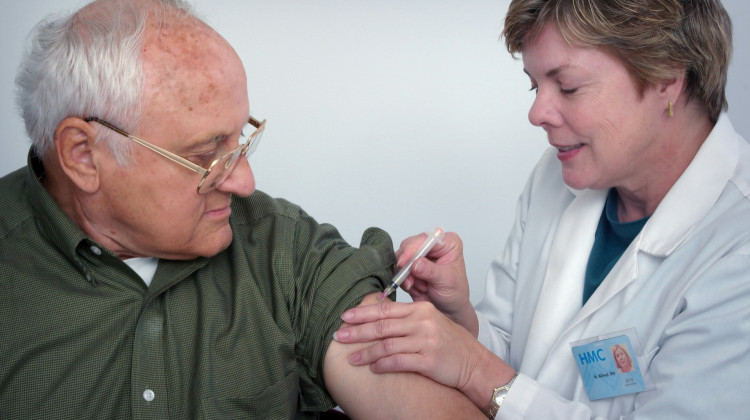
Catherine Hillestad, the CEO of Adair County Memorial Hospital in Greenfield, Iowa, stands in the medical-surgical unit. A tornado in May damaged the entire hospital, shutting it down for months for repairs.
Natalie Krebs / Side Effects Public MediaIt only took one minute for an EF-4 tornado to rip through the small town of Greenfield, Iowa, last May.
Violent winds with a recorded speed of up to 185 miles per hour and flying debris killed four people. Some weather researchers say wind speed may have actually reached 300 miles per hour. It directly hit and destroyed more than a hundred houses, and severely damaged many more structures, including the Adair County Memorial Hospital.
The tornado went right by the 25-bed hospital. It blew out its windows and sent a car flying into the side of the building.
“[The] big thing is our roof was essentially torn off…that allowed water to leak through,” Catherine Hillestad, the hospital’s CEO, said. “So we did have extensive water damage throughout the building.”
Standing in the medical surgical unit, which three months later, is still under construction, along with most of the hospital, Hillestad said every single department sustained damage.
She pointed to a giant window in the unit overlooking the path of the tornado.
“There were glass shards on our wall, so we had to essentially tear everything down, re-drywall it, and then repaint it,” she said.

It’s been an active season in the Midwest for disasters like flooding, which is fueled by climate change, and tornadoes, which are due to factors like warm and cold jet streams getting trapped in an active storm. These natural disasters strike in a matter of minutes – even seconds, but they can have long-lasting consequences for community health.
Long lasting health impacts
The damage shut Adair County Memorial down. Some services have been relocated to the elementary school across town. Hillestad said many residents have also had to travel as far as an hour away for care over the summer.
“One of our goals is to keep patients local, and so without the emergency room, without the operating room, we haven't been able to do that as much from the tornado,” she said.
The hospital reopened some outpatient services and expects to open more units in coming months, but Hillestad said she expects there to be long lasting mental health impacts from that terrifying afternoon.
“The PTSD [post traumatic stress disorder], the trauma that was inflicted upon multiple people,” she said. “I think that's going to be the biggest thing that we're going to be seeing after the event.”
Sudden extreme weather events like flooding and severe storms can have many negative consequences for mental health, including trouble sleeping and depression-like symptoms.
A growing body of research has linked climate change to mental health concerns.
Scientists have not conclusively linked tornadoes to climate change, but the emotional impact can be as devastating as other climate change-related disasters.
Often issues like post traumatic stress disorder don’t show up until months after sudden traumatic events, said Tammy Jacobs, the hotline manager for Iowa Concern, which provides resources after disasters.
“Whenever…the sky gets gray and black again then those who have experienced tornadoes, they just start to remember that experience that they had with the tornadoes,” she said. “When it starts to rain, sometimes when they start to take a shower, just the sound of water can bring back that fear of, ‘Am I going to come back to a house? Is my house going to flood again?”
Many people also face ongoing stress trying to figure out disaster assistance options and what to do with their damaged home, Jacobs said.
“The majority of folks don't have flood insurance. Their homeowners insurance will pay for very little of the things that were impacted. So, just the frustration of working through, trying to rebuild. Making that decision, ‘Do I rebuild? Do I relocate?’” she said.

Incomplete or improper repairs after flooding can lead to a host of issues besides the mental strain. For example, standing water in a home can lead to mold, which can cause breathing problems and neurological issues for children.
“It could also create a breeding ground for mosquitoes, which are vectors of disease,” said Alicia Vasto, the water program director at the Iowa Environmental Council.
Vasto said she’s also concerned about drinking water contamination when flood waters push agricultural runoff, sewage and other hazards into water supplies.
“Private wells or public water sources where they're drawing that water from and have increased amounts of bacteria or other kinds of chemicals that would be dangerous to human health,” she said.
The problem will only get worse
These health concerns are only likely to continue – and even get worse. The Midwest has seen record-high tornado activity this year, and the number of off-season tornadoes is expected to increase due to a future warmer climate, according to the National Oceanic and Atmospheric Administration.
Parts of the Midwest also continues to experience severe flooding due to rising temperatures from climate change.
Addressing these increasing disasters means addressing climate change. Environmental health experts like Maureen Lichtveld at the University of Pittsburgh say policymakers should work with communities that are affected even if some people may not recognize climate change as a threat.
“They might not call it climate change, but if flooding or tornadoes are their concerns, we need to meet them where they are, and we need to come up collaboratively with solutions,” she said.
Side Effects Public Media is a health reporting collaboration based at WFYI in Indianapolis. We partner with NPR stations across the Midwest and surrounding areas — including KBIA and KCUR in Missouri, Iowa Public Radio, Ideastream in Ohio and WFPL in Kentucky.
 DONATE
DONATE







 Support WFYI. We can't do it without you.
Support WFYI. We can't do it without you.